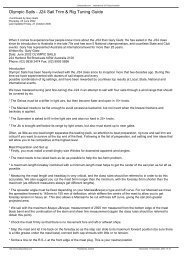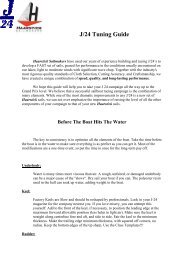North Sails Coronado 15 Tuning Guide.pdf - Sailmaker.org
North Sails Coronado 15 Tuning Guide.pdf - Sailmaker.org
North Sails Coronado 15 Tuning Guide.pdf - Sailmaker.org
- No tags were found...
Create successful ePaper yourself
Turn your PDF publications into a flip-book with our unique Google optimized e-Paper software.
<strong>North</strong> <strong>Sails</strong><strong>Coronado</strong> <strong>15</strong> <strong>Tuning</strong> <strong>Guide</strong>Sail Information || C-<strong>15</strong> News || C-<strong>15</strong> <strong>Tuning</strong> <strong>Guide</strong> || Contact C-<strong>15</strong> Experts || OrderProper boat speed depends mostly on constant and consistent adjustments to your rig and sails. Thefollowing measurements are those that we have found to be the fastest settings for you new <strong>North</strong> sails.We have brushed and tested different tuning settings to be sure that we have the fastest and easiestmeasurements available. If you have any questions or problems with your speed or sails, please don’thesitate to call.MAST BUTT PLACEMENT: The back edge of the stock butt plate should be 111” from the inside of thetransom when measured along the floor of the boat. The back edge of the mast, when sitting on theforward pin in the step, should be 114” from the transom.MAST RAKE: To measure your mast rake, hoist a metal tape measure on your main halyard, lock it, andhold the tape tight at the top of the transom in the middle of the transom. The measurement is alwaystaken with the jib up, and with all the load on the jib halyard and luff wire. This measurement should be23’ 5” in heavy air and 23’ 6” in light air.RIG TENSION AND SHROUD PLACEMENT: We suggest setting your shrouds so that the rig will betight enough that the leeward shroud will not go slack sailing upwind until the wind is blowingapproximately 10 mph.An excellent method to determine a more precise tension is to use a small Loos Tension Gauge Model Aon the shrouds (See Tension Gauge Conversion Chart). The reading with this smaller tension gauge willbe 18. In light air this reading should be around 200 lbs., in heavy air it should be around 300 lbs (over<strong>15</strong> knots of wind)SPREADER LENGTH AND CANT: Your spreaders (with the standard mast) should be 19” long, with a 6”sweep. Spreader cant will be determined by your crew weight. Heavier crews will sails with shorternumbers (spreader tips farther apart.)MAST PREBEND: With the proper rake, rig tension, and spreader set your mast should developapproximately 1/2” of positive prebend when sighted up the back of the mast.MAST BLOCK: At this point, the mast should be blocked at the deck in order to limit mastbend. This willinsure that the mast will not overbend and overflatten the mainsail in heavy winds.NOTE: It is suggested to remove this block downwind to avoid any undue strains on the mast at decklevel.MAIN CUNNINGHAM AND JIB CLOTH: For both the main and jib, never apply more luff tension thanis necessary to just barely remove the wrinkles. Most times it is actually better to leave a hint ofhorizontal wrinkles in the lower 1/4 of the luff of your main and jib to be sure you haven’t pulled tootight.
JIB LEAD TRIMLINE: Your <strong>North</strong> jib is built with a “trimline” penciled in from the clew grommet outtowards the body of the sail. This is the most accurate check in determining proper jib lead position.When the jib lead is positioned properly, your jib sheet should appear as an exact extension of thetrimline. At this point both telltales, tip and bottom, should break evenly as the boat is luffed into thewind.In heavy winds, when the boat is overpowered, move your jib leads aft as much as 2” at which pointyour jib sheet will angle slightly aft of the trimline and your jib will become flatter up top with the leechmore open.JIB SHEET TRIM: Unfortunately, there is no easy guide for trimming the jib sheet. We are looking for aparallel slot between the exit of the jib and the entry of the main. The guide which has been verysuccessful is that of imagining a middle batten on the jib at mid-leech. This “batten” should be setparallel to the centerline of the boat which will make the upper half of the jib leech twist outboardslightly, and the lower half twist inboard slightly. In light air, 1-2” off shroud base, in medium air the footshould be curled to just touch the chainplate and in heavy air there should be a horizontal creaseappearing along foot.It is important to be careful not to overtrim the jib and hook the imaginary batten tighter than parallelwith the centerline of the boat. It seems that 90% of the boat speed problems experienced are due tofaulty jib sheet trim.MAINSHEET TRIM: Trim the main through use of the mainsheet and the boomvang so that the last 1/3of the upper batten is parallel to the boom (sighted from under the boom, looking up the sail.) In lightwinds it will be impossible to keep the upper batten from hooking slightly to windward due to the largeroach of the C-<strong>15</strong> main. In these conditions set the upper batten parallel to the centerline of the boat(instead of parallel to the boom.) This will position the boom farther off centerline which is acceptablesince in light winds the boat is driven much harder and not pointed near as much as it is in medium andheavy winds. It is also important to try to keep the leech telltales flying in all conditions.In heavy winds, maximum mast bend will open the upper leech so that the upper batten will be angled 5to 10 degrees out from parallel to the boom.BOOMVANG: Downwind we trim the vang just enough to keep the boom down and the leech “set” onthe mainsail (the back 1/3 of the upper batten parallel to the boom.) Because the shrouds are swept aftpreventing the boom from going out on a run, ease the vang to allow the top batten to be perpendicularto the wind when running.Upwind it has become popular to use the vang to keep the upper batten parallel and force more bendinto the mast. In puffs, when the mainsheet must be eased out quickly to help balance the boat, easingthe mainsheet in a puff would actually allow the mast to straighten up, causing the sail to become fuller.In effect, keeping the vang set tight upwind in a breeze will actually set the tension down on the boom,allowing the mainsheet to control the angle of the boom to the centerline.TRAVELLER: The traveller is used to further depower the main. The skipper should be able to easilyreach the traveller controls while hiking. This way, when a puff hits, it is easy to drop the traveller toleeward to keep the helm and boat balanced. When the wind lightens, the traveller must come back up.In very light winds, pull the traveller to windward to help keep the boom closer to centerline and stillmaintain the aft 1/3 of the upper batten parallel to the boom. Be sure to pull it up to windward as quicklyafter a tack as possible and not leave it to leeward for any length of time.
Boom end sheeting with a bridle traveler is becoming more popular in the C-<strong>15</strong> class. The height of thebridle should be determined by the mainsheet almost being able to “two-block” in a medium (12 to <strong>15</strong> )mph wind. If your bridle and mainsheet blocks touch before proper mainsheet tension has been applied,the boat will not develop top speed or pointing capabilities.Many C-<strong>15</strong> sailors are now using a “split mainsheet” boom end system which makes trimming themainsheet much easier. Basically a purchase is reduced at the end of the boom so that the travellerbridle legs can be sewn into the mainsheet where it enters the boom end block. Call us if we can helpyou set this up.OUTHAUL: Pull the outhaul to the band except in very light or choppy conditions when extra power isdesired. In these conditions it is advantageous to ease the outhaul 1” to 2”. When the outhaul is pulledout tight you will notice the beginning of a crease just above the boom. This crease is normal as it is theextra fullness built into the sail for power when the outhaul is eased.<strong>North</strong> C-<strong>15</strong> sails have been designed to be fast and easy to adjust. If you have any questions orproblems please don’t hesitate to give us a call.For tuning help contact the <strong>North</strong> C-<strong>15</strong> experts.
















